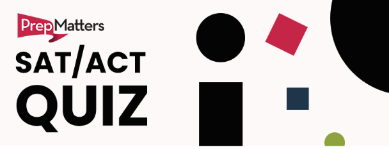Posted on: August 2, 2024
About the SAT Reading Section
Unlike the ACT, which features separate English and Reading sections, the SAT has only one Reading and Writing section, which includes both reading comprehension questions (the focus of this blog) and grammar questions (the subject of the next). The other major difference between the reading sections of the ACT and SAT is that the SAT no longer features long passages with multiple questions as do most standardized tests that students have seen before. The digital SAT now gives students a short new reading passage with each question – no more than a paragraph or two and often less. Each Reading and Writing section (module) includes 27 questions and lasts 32 minutes, totaling 54 questions and 64 minutes overall. Furthermore, the SAT reading section gives students more time per question than the ACT does.
So, what’s the downside? Although this SAT section has fewer questions, shorter passages, and more time than the ACT Reading and English sections have, most students would say that the SAT Reading section is a lot “trickier” than its ACT counterpart. We would say that it’s more complex and nuanced. Those shorter reading passages employ a higher level of diction (i.e., harder vocab words!) and more complex sentence structures that convey what are often more abstract concepts. In addition, the wrong answer choices on the SAT tend to be more subtle, often containing some truth even when the response is incorrect.
Compared to questions on the ACT, the SAT Reading and Writing questions will often require students to engage more fully with what they are reading and to make logical deductions based upon evidence that is presented in the passages.
SAT Reading Strategies
The SAT primarily tests students’ close reading skills. And the best way to have developed those skills is to have spent as much time as possible reading from a variety of challenging sources. Although more reading practice can always build skills, a quick score improvement for many students can come from understanding exactly what the test is asking you to do. Here are our best strategies for making sure that you are making the most of the reading skills you already possess.
Strategy 1: Should You Read the Question First?
Because there’s only one question per passage on the SAT, it makes sense to read the question stem – the “question” asked of you in the few lines above the answer choices – before reading the entire passage. Here’s an example of a common SAT reading question type. You could be asked to choose an answer that strengthens the author’s argument or that weakens his argument. Those are both question types on the SAT. But how you read that passage will very much depend on what you’re looking for in the passage. Looking for reasons why the argument is good and why it could fail are two very different things, and it helps to know what you’re looking for so that you don’t need to read that passage again after you’ve read the question!
Strategy 2: Ignore the Answer Choices
Unlike questions on other sections, for which answers can often be logically tested or provide useful clues for understanding the question, SAT Reading questions have answers that tend to be less helpful and may only confound and distract you. So, reading the question and then immediately reading the answer choices often leads students to draw the wrong conclusions. Instead, students are far better served by reading the question and then ignoring the answer choices until they first find the right answer in the text. Students can then return to the answer choices, armed with the textual evidence they need to determine which answer choice is correct.
Strategy 3: Predict the Answer Yourself
The most successful test-takers don’t first even find the evidence in the text but will use the evidence they find to create their own answer to the question. In other words, they use the text to predict the answer themselves. With that prediction in hand, it’s far easier to find the right answer choice – and far harder to fall for the trap answer choices.
SAT Reading Questions and Answers
For many students, the hardest part of the reading test isn’t the reading passages or the questions – but selecting from among the answer choices. The reason that many call the SAT a “trickier” test than the ACT, though we like to say is more abstract and nuanced. That’s particularly true of the answer choices: is because the wrong answers on the SAT tend to be more tempting. Here are a few “trap” answers that you’ll need to learn not to choose:
Trap 1: Extreme Answers
Stronger claims require stronger evidence. If someone claims that some ducks are purple, they need only show one thing that can be described as a purple duck. If, however, someone claims that all ducks are purple, a lot more work is needed to prove the point. For that reason, answer choices that use less general language (e.g., “some” rather than “all”) are much more likely to be right because they’re easier to support.
Trap 2: Finding the Flaws
In fact, always look for flaws rather than correct answers. These tests include answers that sound good and may possibly be true, but it’s better to look for answers that must be true based on the text. Looking for the right answer tends to creatively engage you, while finding flaws tends to keep you thinking more analytically, which is more desirable on this section. Between two answer choices, determine which has the word or phrase that is easiest to quibble with and then choose the other answer.
Trap 3: The Right Words the Wrong Way
One final type of wrong answer is one that uses the same words as in the text, but in a different way. Perhaps the answer uses a phrase from the text correctly, but then includes small incorrect details. If any part of an answer is wrong, the whole thing is wrong.
Trap 4: Simplicity
A lot of students fall into the trap of picking a choice that they find interesting because they can make a case for how the passage could be read that way. But that’s not the job here! The more steps away the answer is from what was literally stated in the passage, the less likely it is to be the right answer. Stick to the boring answers, and never ever cross out a choice because it seems “too obvious.”
How to Improve Your SAT Reading Score
Not everyone needs a perfect score on the SAT Reading and Writing section. In fact, the SAT Reading and Writing section is the hardest section of either the SAT or the ACT on which to achieve a perfect score. Think about where you are and what you need to do to hit each benchmark along the way to your goal. And, of course, the Reading and Writing section is only half reading, so hitting your goals will also depend on your Writing (grammar) skills.
Getting to a 500: You can still break 500 before getting to that harder second reading module, so don’t worry about that yet. Focus on answering the types of questions you like best — and try to make your decisions based on what you KNOW rather than what you don’t know. There is likely to be vocab you don’t know, but you’ll have to do your best to make use of what you do know and to make the best answers you can.
Getting to a 600: At this point, you might be getting the easier or harder second module. Either is possible for achieving a score of 600. It should likely be clear to you as you work through that second module which one you’ve got. So, if you’re seeing really hard questions, pat yourself on the back for doing well on the first section and try to get as many points as you can as you make guesses where necessary. If, on the other hand, you get the easier second section, that’s still ok. Just make sure that you execute well so that you pick up as many points as you can. You can still break 600 if you do well!
Getting to a 700: You’re definitely getting the harder second section at this point – and you should also be doing well on it. You’ll need a very good understanding of the types of questions and answers on the test, so, as you continue to work through questions, you should focus not only on what the right answers are but why you chose the wrong answer you did. What kind of trap did you fall into? What didn’t you notice about the correct answer? You’ll need to be very self-aware to make progress at this point.
Getting to a 800: Just stop. You’ll need to be basically perfect to be perfect. It’s incredibly difficult to hit the 800 mark and, in general, it only happens for kids who just love to read. So, if you’ve got a time machine to go back to 8th grade and start recreational reading for about an hour a day, that would be your best bet. More seriously, congratulations for even being in this range! Try to keep the test and test day in perspective and treat it just like the practices you’ve been crushing. Stay cool, make good decisions, and hopefully you’ll have the perfect day you want.
SAT Reading vs. ACT Reading
If you’re still trying to decide whether the SAT or ACT is better for you, you should likely start by examining the reading sections. Those are the most different from one another and can likely help you make your decision more quickly. As a more typical reading comprehension test that features long passages with multiple questions, the ACT places a greater burden on a student’s comprehension and recall than does the SAT. The ACT also has – as usual – the more speeded section and so also requires a fairly high processing speed and the ability to read quickly and well. The SAT, on the other hand, doesn’t require fast reading or good recall, but it does require students to parse more complex language and deal with more advanced vocabulary. It’s impossible to say that one test is easier or harder for everyone, but one of them may be easier or harder for you. There’s no better way to find out than to dive in and to try each section!
Common Questions about the SAT Reading Section
How many passages are on the SAT reading section?
The digital SAT features short passages with each question rather than longer passages with multiple questions. Each Reading and Writing module includes 27 questions and lasts 32 minutes for a total of 54 questions and 64 minutes overall.
Should I read the question before the passage on the SAT?
Yes. Since there’s only one question per passage, reading the question stem first helps guide what to look for in the passage.
Why are SAT answer choices considered tricky?
SAT answer choices are more subtle, often containing some truth even when incorrect, which can mislead test takers.




